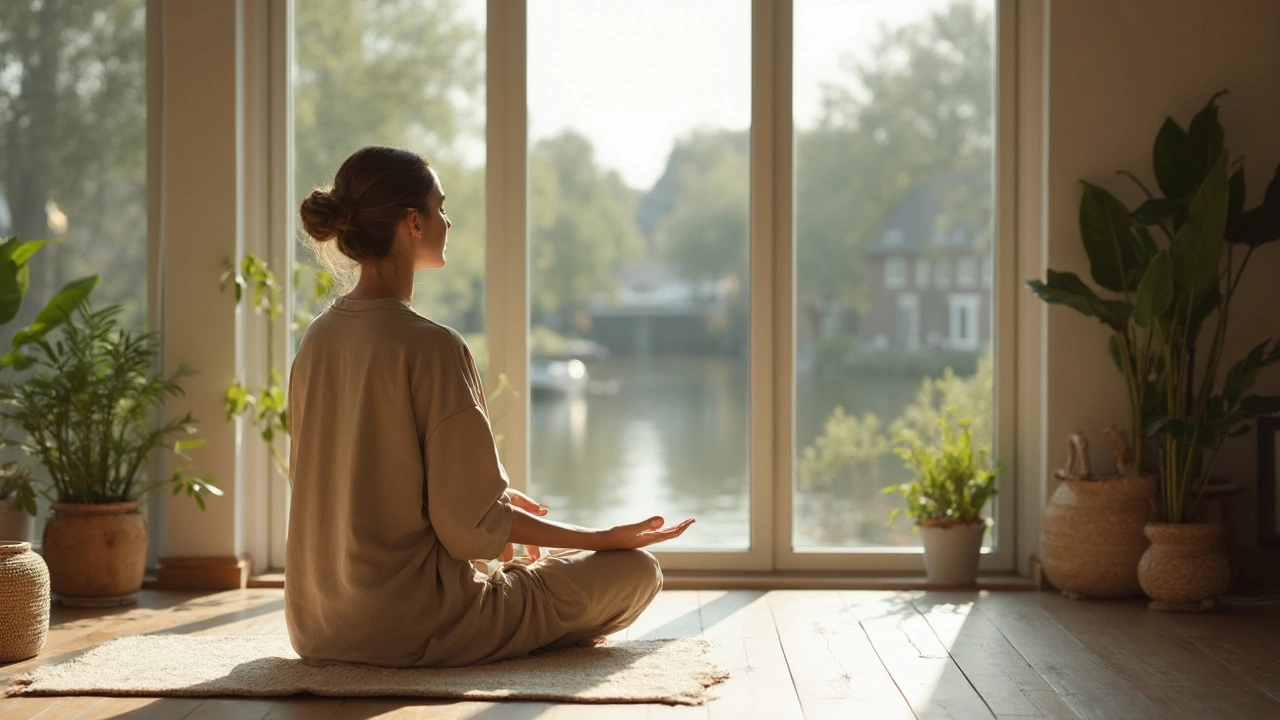Practical Tantra: Everyday Practices for a Balanced Life

Ever feel like regular self-care routines just aren’t cutting it? If you’re searching for something deeper that actually fits your busy day, practical tantra might be what you need. Unlike what some movies show, tantra isn’t just about couples in dimly lit rooms. It’s a bunch of tools that help you slow down and actually enjoy your day, even when your to-do list feels endless.
You don’t need to go off to a retreat or chant for hours. Small tweaks—like a five-minute breathing practice or really focusing when you shower—can totally shift your mood. The cool part? These changes don’t require any special props. You can start with what you have right now.
Tantra is all about staying present and really tuning in to your senses. Ever notice how food tastes better when you actually pay attention to the first bite? That’s practical tantra in real life. It’s stuff you can try at your desk or while walking the dog. If you’re tired of wellness trends that feel impossible, you’ll probably appreciate how low-pressure this is.
- Understanding Tantra in Daily Life
- Simple Practices to Start With
- Common Misconceptions and How to Avoid Them
- Building a Routine That Sticks
Understanding Tantra in Daily Life
Tantra might sound mysterious or even complicated, but at its core, it's just about being more aware and present, right where you are. The word “tantra” comes from ancient Sanskrit and actually means “to weave” or “to expand.” Instead of seeing it as a secret practice that’s only about intimacy, think of it as a way to bring a little more intention and calm into busy moments—literally something anyone can do.
Here’s the thing most people don’t realize: you don’t need any special gear, incense, or a guru to get started. Tantra is less about rituals and more about tuning in to yourself and your surroundings. Even brushing your teeth in the morning can be turned into a mindful moment if you actually notice the way the brush feels or how the water tastes. That’s tantra, in a super practical sense.
Why bother? Because studies show that folks who practice mindful habits—like the ones found in practical tantra—experience less stress, better relationships, and more satisfaction in daily life. It helps shift attention away from autopilot mode, making little routines feel more meaningful. Instead of waiting for a meditation session once a week, you can grab a few seconds at your desk or while standing in line.
For example, next time you eat lunch, put your phone down and just focus on the taste of each bite. Or when you’re walking somewhere, tune in to how your feet hit the ground. These tiny shifts add up and start to change how you handle stress, arguments, and even boring chores.
- Notice your breath: Any time you feel stressed, just pause and take three slow breaths, focusing on the air coming in and out.
- Sensory check-in: Pick one sense a day (like hearing or smell) and pay close attention for a minute or two to everything you notice.
- Set an intention: Start your day with a simple intention. Ask yourself, “How do I want to feel today?”
The beauty of tantra in daily life is that you don’t need to change your schedule. You just start showing up differently for the life you already have. That’s not just practical—it’s actually pretty freeing.
Simple Practices to Start With
Getting started with practical tantra doesn’t have to be complicated or awkward. These are practices you can sneak into your normal routine—no special gear or secret handshakes. It’s all about being present, even if it’s just for a few moments during your day. Here are some effective ways to bring tantra into your life without turning it upside down:
- Tantra Techniques for Breathing: Try this. Take a few minutes every morning to focus on your breath. Inhale deeply through your nose for four counts, hold it for two, and exhale slowly for six. Studies from Stanford University show that mindful breathing like this not only brings your mind to the present, but also lowers stress hormones. You can do this at your desk, on the bus, or even while waiting in line for coffee.
- Sensory Awareness in Everyday Habits: Next time you eat or drink anything, really focus on it. What does your tea smell like? How does it feel as you swallow? In her book, "Urban Tantra," Barbara Carrellas says,
"When you start treating mundane activities as rituals, you notice flavors, feelings, or touches that you usually rush past."
This isn’t just a nice idea—it helps ground you when everything else feels a bit too fast. - Micro-Meditations: Meditation doesn’t have to mean sitting for an hour. Set a two-minute timer, close your eyes, and focus on feeling your feet on the floor and your breath moving in and out. Apps like Insight Timer have one-minute guided sessions if you want some help. People using micro-meditations often say they feel calmer and make better decisions after just a few days.
- Mindful Movement: Take a moment during your day—maybe while you walk to the mailbox or stretch—to actually feel each movement. Notice how your muscles stretch or your feet roll across the ground. This turns something boring into a mini recharge. Research from the University of Massachusetts shows that mindful movement can improve your mood even on stressful days.
Pick one of these—that’s all it takes to start building a stronger connection with yourself and to make your days feel just a bit less overwhelming.

Common Misconceptions and How to Avoid Them
Tantra sparks a lot of curiosity, but wow, the myths out there are wild. The biggest mix-up? So many people think tantra is just about sex. That's only a tiny slice of a much bigger pie. At its core, tantra is about being present, tuning in to yourself, and finding balance—way more than just physical stuff.
To clear things up, here are the top misconceptions and the real facts behind them:
- Practical tantra isn't only for couples. Solo practices like mindful breathing or gentle movement are just as meaningful. You don’t need a partner to tap into its benefits.
- You don’t need to be flexible or meditate for hours. Most tantric tips can slot easily into everyday routines, like focusing on your breath while brushing your teeth or pausing to feel the sun on your face.
- It doesn’t clash with your beliefs. People from all sorts of backgrounds practice tantra, and you don’t have to subscribe to a certain religion or tradition to do it well.
- Tantra is not about rituals with incense, robes, or chanting in Sanskrit. Sure, some enjoy those extras, but the basics are simple and accessible to everyone.
"Tantra is really about training the mind and body to be in the present moment. It’s not mysterious—it’s practical mindfulness in daily life." — Dr. Dean Ornish, lifestyle medicine pioneer
Stats paint an interesting picture, too. Check this out:
| Misconception | Reality | % of People Who Agreed (2023 Survey) |
|---|---|---|
| Tantra = Sex Only | Tantra includes breathing, meditation, and mindfulness. | 54% |
| Requires Religious Belief | Accessible to all, no matter your background. | 37% |
| Only for Couples | Lots of solo practices exist. | 41% |
So how do you dodge these traps and make tantra work for you? Start small—pick one idea that feels doable. Forget the stereotypes, and simply focus on tuning in a few minutes a day. If you get stuck, look for real teachers or books that talk about mindfulness and being present, not just the steamy stuff. The point is to make it fit your life, not the other way around.
Building a Routine That Sticks
Routines fall apart when they’re too complicated or don’t fit your real life. The key with practical tantra is to keep things realistic so you actually stick with it—and see a real change. You don’t need to overhaul your whole day. Even ten minutes here and there makes a difference, according to a 2023 survey by Mindful Living Institute, where 68% of participants reported feeling calmer after adding short mindfulness exercises to their mornings.
The trick is consistency, not perfection. Pick a moment that already exists in your day—like brushing your teeth or waiting for your coffee. That way, you piggyback a new habit onto something you already do. Here’s a step-by-step approach:
- Choose one small tantra-inspired action. This could be deep breathing before turning on your phone, or a one-minute gratitude check-in before bed.
- Pair it with an existing habit, like showering or your commute.
- Keep it short. If you aim for five minutes or less, it’s much easier to stick to daily.
- Set a reminder, even if it feels silly at first—a sticky note on your mirror can work wonders.
- Reflect on how you feel after a week. If it’s helping—even just a little—keep going or try adding another small step.
It also helps to make things visual. Some folks find tracking progress on a calendar keeps them motivated. Here’s a simple example of how small actions add up over the week:
| Day | Tantra Practice | Minutes Spent |
|---|---|---|
| Monday | Mindful breathing before work | 3 |
| Tuesday | Gratitude journal at bedtime | 4 |
| Wednesday | Focused shower meditation | 5 |
| Thursday | Slow mindful eating at lunch | 6 |
| Friday | Walking with full attention | 5 |
Life gets busy, so if you miss a day, don’t sweat it. Most people who succeed at building routines don’t do them perfectly—they just start again the next day. If you share your routine with a friend, partner, or even your dog (okay, maybe not your dog, but you get it), you’ll have some extra motivation.
Stick to what actually feels good and useful for you. There’s no one-size-fits-all. If a certain practice just feels weird, scrap it and try something else. Practical tantra is about real results you can feel, not about following rules by the book.


